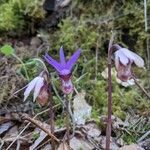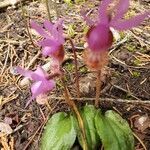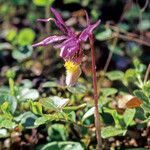Scape 1–2 dm; lf-blade round-ovate, 3–5 cm, often basally cordate, the petiole about as long; sep and lateral pet pale purple (white), 1–2 cm; lip 1.5–2.3 cm, whitish, becoming yellowish toward the tip, marked with red-brown inside, the apron white, spotted with purple and crested with 3 rows of yellow hairs; column 8–12 mm. Moist coniferous woods; circumboreal, s. in Amer. to N.Y., Mich., Minn., N.M., Ariz., and Calif. May, June. (Cytherea b.) Our plants have been segregated as var. americana (R. Br.) Luer.
A small orchid. It is about 20 cm high. It has a single leaf. This can be 3-6 cm long by 2-5 cm wide. It is oval in shape and has a wavy edge. The leaf lies close to the ground. There is an underground storage corm. It is about 1-2 cm across. The flower is single and nodding. It is about 3-4 cm long.



